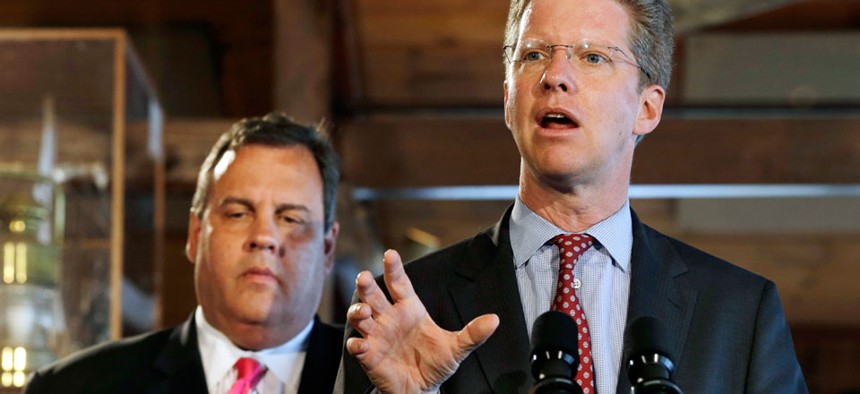
HUD Secretary Shaun Donovan speaks with New Jersey Governor Chris Christie about storm rebuilding and recovery. Mel Evans/AP
Shaun Donovan Wants to Reinvent the Way We Do Disaster Recovery
The HUD Secretary on how we should be innovating climate resilience after Sandy.
When he announced Rebuild by Design back in June, Housing and Urban Development Secretary Shaun Donovan, who chairs the Hurricane Sandy Rebuilding Task Force, said that itwouldn’t be your typical design competition. "The success of this competition will not be measured simply by producing theoretical solutions," he said. "Rather we want proposals that will have an impact on the ground, in people’s lives."
Today, the task force announced the 10 teams selected to engage in the ambitious program (full list below), part of the much larger effort to rebuild storm-gutted communities in New York and New Jersey. The teams, composed of experts from a variety of disciplines, weren’t selected because they submitted fancy renderings of proposals. In fact, they haven’t submitted proposals yet. Instead, they won on the basis of the range of expertise they were able to assemble from across fields such as architecture, engineering, marine science, and industrial design, and on the innovative nature of their approach to the problems at hand.
More than 140 teams from some 15 nations applied. The winners, including participants from Denmark, the Netherlands, the United Kingdom, Mississippi, New York, and many other places, will spend the next three months studying the region and building relationships with local stakeholders. The next three months will be dedicated to creating designs focused on four areas: coastal communities; high-density urban environments; ecological and waterbody networks; and "the unknown and unexpected." Implementation of the resulting designs will begin in March 2014, funded in part by federal community development block grants. The Rockefeller Foundation is a lead supporter.
Secretary Donovan came to his hometown of New York to launch the working phase of the initiative on Thursday. He sat down to answer some questions about how it’s all going to play out, and about how the resulting projects might serve as a model for communities facing the effects of climate change around the country and around the globe. This is an edited version of our conversation.
What are you hoping for in terms of the types of solutions coming out of this? How might they serve as scalable models for communities outside the New York/New Jersey region?
The value of a competition is it makes innovation possible at a scale that’s incredibly difficult to do in general, and particularly difficult to do in traditional government processes.
I think we can talk some about the types of solutions, but part of what’s so exciting about this is the unknown and unknowable before the competition is actually run. Part of what we are looking for is what we don’t know we’re looking for.






